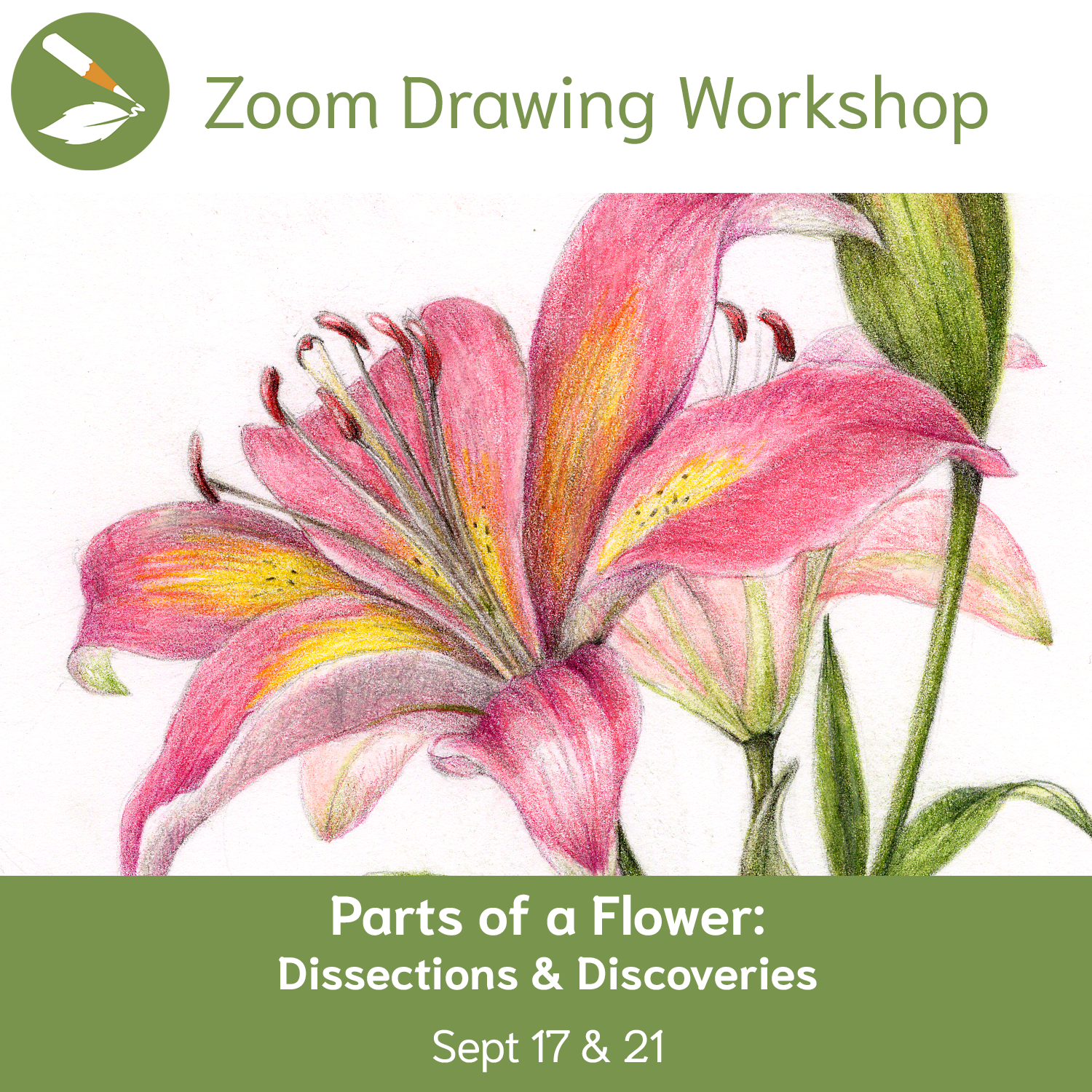If you’ve ever been fascinated by a flower, this post is for YOU!
Check out some of the helpful drawing tips taught in our course, The Practice of Botanical Drawing!

A flower is the reproductive part of a plant. Its primary purpose? To attract!
How do these alluring seed-bearing wonders do it? Let’s examine the captivating forms, vibrant colors, and enchanting fragrances flowers use, along with their promise of sweet nectar, to make themselves irresistible to any pollinator (or person!). Prepare to be captivated by the mesmerising world of flowers!
Discover the magic of bringing white flowers to life on white paper! Join our experienced instructors on this delightful and creative journey to expose the secrets behind making cheerful daisies pop off the page using a harmonious blend of colored pencil and watercolor.
In this enchanting session, we’ll delve into advanced flower drawing techniques, including:
🎨 Sensitive Line: Learn the art of delicate and expressive lines that capture the essence and free spirit of each flower.
🌸 Petal Perfection: Get hands-on practice in drawing petals with precision and grace.
🔍 Perspective: Achieve flower portraits from various angles, giving your drawings depth and realism.
📏 Accurate Drawing: Hone your skills in accurate representation to make your flowers truly lifelike.
🌈 Subtle Color: Discover how to use gentle hues to create a stunning 3-dimensional effect, making your white flowers stand out on white paper.
Whether you’re an experienced artist looking to refine your skills or a curious beginner eager to explore the world of botanical art, this workshop is perfect for you. Grab your favorite colored pencils and watercolors (here are our favorites), and let’s make some floral magic together!
Register for White Flowers Zoom Workshop
Scroll for helpful information on drawing flowers, or click below to jump to a specific section:
+ Botanical Fun Facts
+ Flower Drawing Tips
– Shapes
– Symmetry
+ DIY Reference Tools
– Herbarium Page
– Study Page
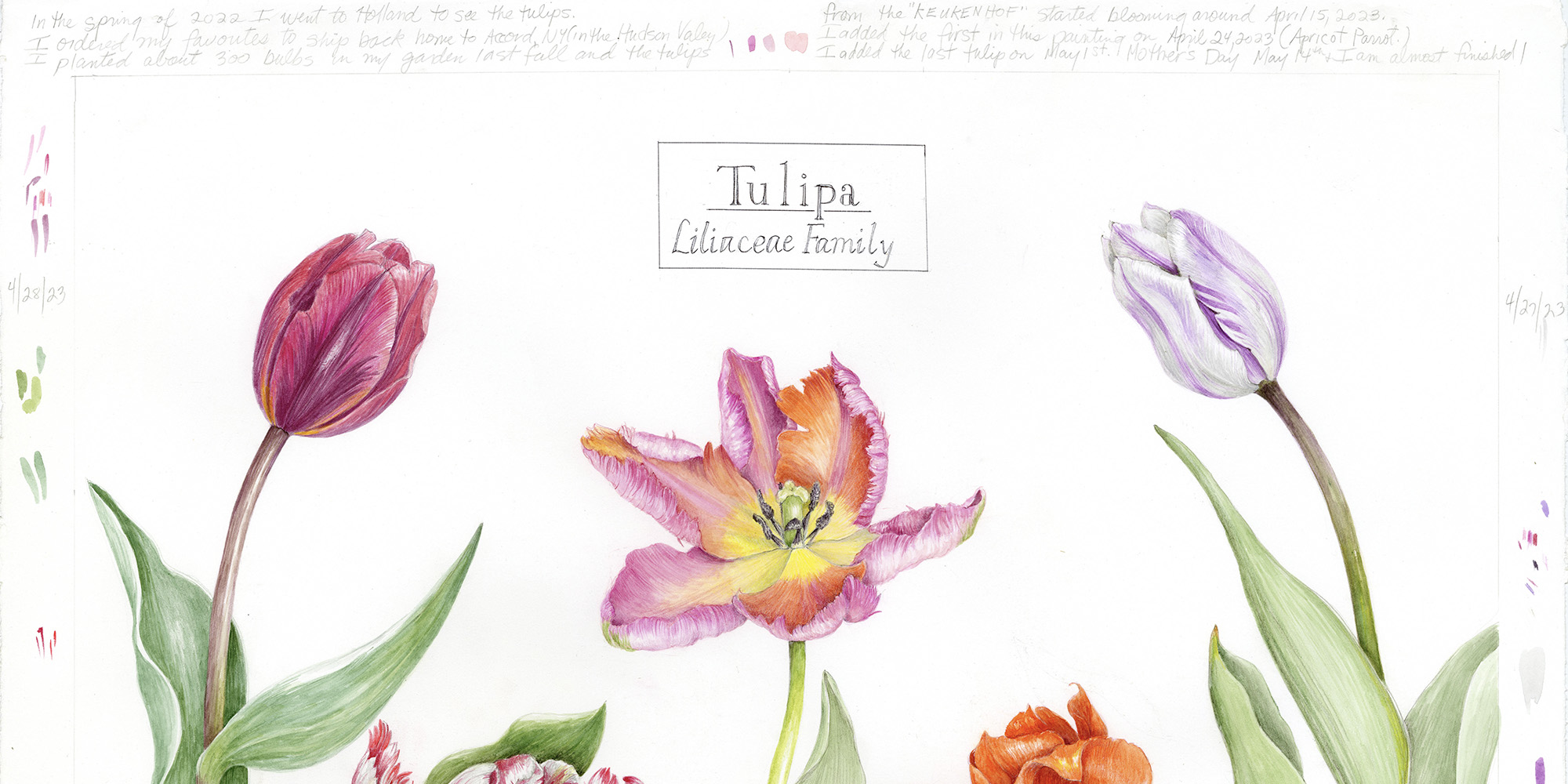
Botanical Fun Facts
Of the nearly 400,000 species of land plants described, nearly 90% are flowering plants known as angiosperms. There are 350,000+ species of angiosperms classified into 400+ families! However, most of their diversity can be found in a few major families – the Asters / Composites (32,000), Orchids (28,000), Legumes (19,000), and Grasses (12,000). (Source)
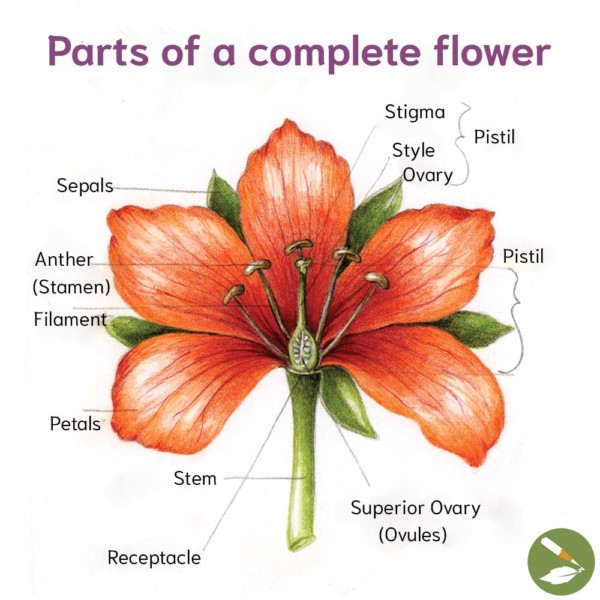
Flowers are very different from one another, but many flowers contain some combination of these parts: stem, petals, sepals, pistils, stamens, and ovules/ovaries.
For a deep dive on flowers and their parts, check out the recording of our Parts of a Flower: Dissections & Discoveries Zoom Workshop!
Learn more & Purchase Here
PS- If you missed our live Zoom workshop on Composite Flowers: Daisies, Zinnias, & Coneflowers, click here to purchase a recording. For other recordings, check out our new Zoom Workshops Archive!

Flower Drawing Tips
Shapes
Look at a flower initially as a simple shape and identify which simple shape is most like your flower subject. (Beginners: Tubular flowers are one of the simplest flower shapes because the three-dimensional form is very evident.)
Here are some common flower shapes to give you an idea:
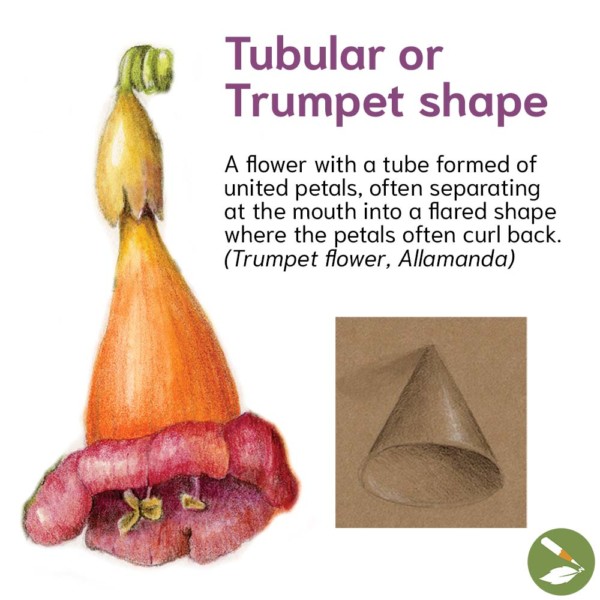
Tubular or Trumpet shape
A flower with a tube formed of united petals, often separating at the mouth into a flared shape where the petals often curl back. (Trumpet flower, Allamanda)
Challenge: Include a pollinator in your botanical composition!
“Flowers with long spurs attract butterflies and birds (like hummingbirds or sugarbirds).” (Source)
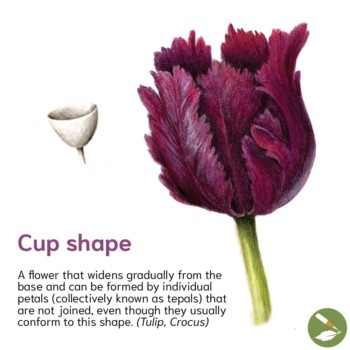
Cup shape
A flower that widens gradually from the base and can be formed by individual petals (collectively known as tepals) that are not joined, even though they usually conform to this shape. (Tulip, Crocus)
Beginners: Learn how to draw a tulip for FREE here – How To Draw a Tulip in 12 Easy Steps
“Cup-shaped flowers are usually pollinated with massive animals like beetles and even bats.” (Source)

Campanulate or Bell shape
A flower with a wide tube and flared petal tips, typical of the Bellflower family. (Nectar campanula or other campanula)
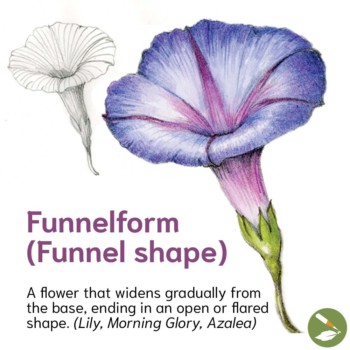
Funnelform (Funnel) shape
A flower that widens gradually from the base, ending in an open or flared shape. (Lily, Morning Glory, Azalea)
“Funnel-shaped flowers as well as labiate flowers (with lips), are adapted to flies and bees.” (Source)
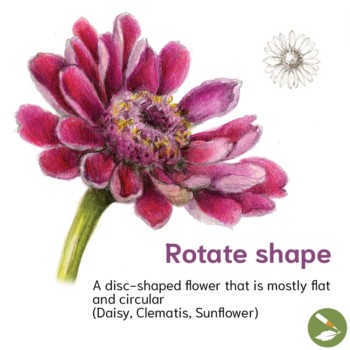
Rotate shape
A disc-shaped flower that is mostly flat and circular. (Daisy, Clematis, Sunflower)
Composite flowers have so much to teach us! All of their petals are perfect for practicing overlaps; their adorable, fuzzy-looking centers are great practice for drawing textures and fibonacci patterns; and their circular form makes foreshortening simple and easy to understand. Watch round circles become ellipses as we draw flowers from different perspectives.
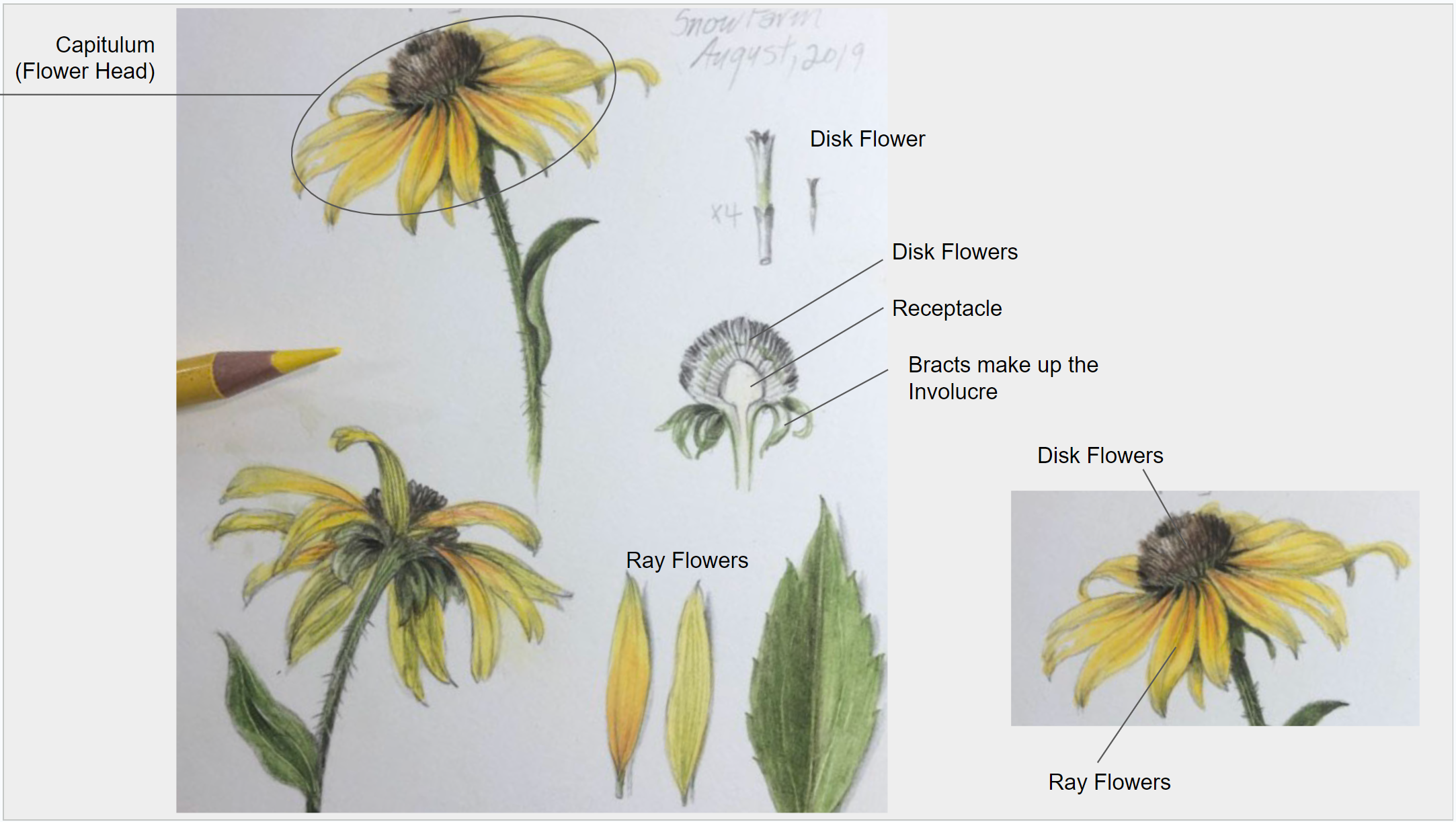
Learn about the botany of inflorescences, their fascinating reproductive parts, and how each petal is actually an individual flower connected to a shared stalk!
Learn more & buy the recording from our Composite Flowers Zoom Drawing Workshop here
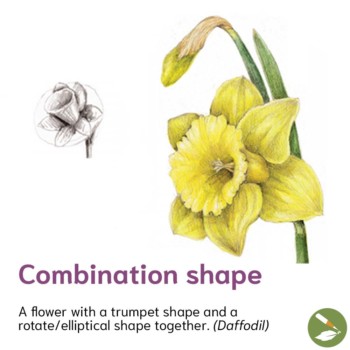
Combination shape
A flower with a trumpet shape and a rotate/elliptical shape together. (Daffodil)
Symmetry
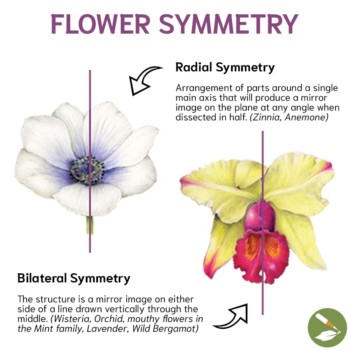
Radial Symmetry
Arrangement of parts around a single main axis that will produce a mirror image on the plane at any angle when dissected in half. (Zinnia, Anemone)
Bilateral Symmetry
The structure is a mirror image on either side of a line drawn vertically through the middle. (Wisteria, Orchid, mouthy flowers in the Mint family, Lavender, Wild Bergamot)
DIY Reference Tools
Herbarium Page
To understand a flower, take it apart in a methodical way. Making an herbarium page will help you learn plant anatomy and the page will serve as a reference tool that will exist long after your live specimen. Once you’ve separated the parts of your flower, examine them through a magnifying glass to see details more easily. Cover the specimen with a piece of scrap paper and press under some heavy books. Your page will be dry in ~2 weeks.

A la Emily Dickinson (yes, that Emily Dickinson), try arranging your next botanical drawing composition to tell a story: whether it is the biography of one plant over time, the connection between two, or the tale of your journey to the place where you discovered a flower. Read more about Emily Dickinson’s herbarium and see her entire digitized collection.
Caution: Beware plants with poisonous parts! Be careful & wash your hands after handling.
Study Page

Drawing the individual elements of the flower before attempting the entire structure can be less intimidating.
On your study page, consider including:
+ the number of petals
+ details about the reproductive parts and leaves
+ color mixing
+ any other things that intrigue you!
Challenge: Create a series of study pages as a document of the seasons!
Petals
Put the petal right on the paper; start with a center axis. For light colors like yellow, draw guides very lightly with graphite pencil and erase before adding color. Use Earth Green or Gray Verithin to add tones. Subtly define the outer edges with Verithin.
Ruffled Corona
Flatten out to see the edges more clearly. Think of the shape as a skirt, a ribbon, or a piece of fabric. Enlarge the section to see the ruffles more clearly. Notice how the petals roll over the top of the corona.
Reproductive Parts
Magnification is essential. Studying plants under magnification opens up a hidden world. The closer you look, the more detail and form you can see to draw. In addition, structure seen under magnification will help you add a 3-dimensional quality to your drawings.
Check out this Joy of Botanical Drawing Video Companion on Measuring and Flower Shapes.
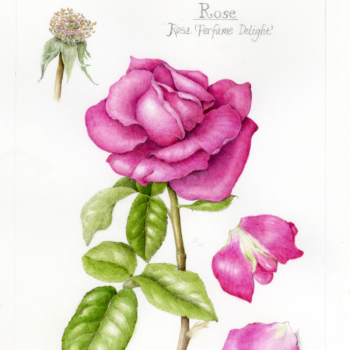
Want to learn how to draw a rose?
Follow Wendy’s step-by-step instructions (for free!) in this post, or check out the Joy of Botanical Drawing Video Lesson Companion: Draw a Rose.
Want to learn more about flowers and how to create herbarium and study pages?
Check out Lesson 5: Understanding a Flower in The Practice of Botanical Drawing.




